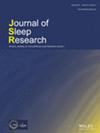REM sleep without atonia and neurocognitive function in isolated REM sleep behaviour disorder: Cross‐sectional and longitudinal study
IF 3.4
3区 医学
Q2 CLINICAL NEUROLOGY
引用次数: 0
Abstract
SummaryThis study investigated the relationship between rapid eye movement sleep without atonia and cognitive profiles in individuals diagnosed with isolated rapid eye movement sleep behaviour disorder, assesssing both cross‐sectional associations and their link to phenoconversion in a longitudinal follow‐up. Participants underwent video‐polysomnography, neurological examination, neuropsychological tests and structured interviews to confirm isolated rapid eye movement sleep behaviour disorder. Rapid eye movement sleep without atonia was manually scored using the Montreal method, and participants were categorized into either high or low electromyography activity groups, based on their tonic and phasic electromyography activities. The cross‐sectional study included 250 patients with isolated rapid eye movement sleep behaviour disorder, revealing that those with high tonic electromyography activity exhibited significantly lower scores in the constructional praxis recall than those with low tonic electromyography activity (孤立的快速眼动睡眠行为障碍患者的快速眼动睡眠(无失张力)和神经认知功能:横断面和纵向研究
摘要本研究调查了被诊断为孤立性眼球快速运动睡眠行为障碍的患者中,无失张力的眼球快速运动睡眠与认知特征之间的关系,评估了横断面关联及其与纵向随访中表型转换的联系。参与者接受了视频多导睡眠监测、神经系统检查、神经心理学测试和结构化访谈,以确认是否患有孤立性眼球快速运动睡眠行为障碍。采用蒙特利尔方法对无失神的快速眼动睡眠进行人工评分,并根据肌电图的强直性和相位性活动将参与者分为高肌电图活动组和低肌电图活动组。横断面研究纳入了250名孤立性快速眼动睡眠行为障碍患者,结果显示,强直性肌电活动高的患者在构思练习回忆中的得分明显低于强直性肌电活动低的患者(p = 0.002)。在纵向研究中,对79名参与者(63名孤立的快速眼动睡眠行为障碍患者和16名表型转换患者)进行了至少5年的追踪调查,结果表明,强直性肌电活动高(几率比:6.14;95%置信区间:1.23-30.60;p = 0.027)和在路径制作测试A中成绩较低(几率比:0.23;95%置信区间:0.11-0.70;p = 0.007)与未来的表型转换有关。这些结果证实,在孤立的快速眼动睡眠行为障碍中,强直性肌电图活动与神经变性之间存在联系。将快速眼动睡眠无张力评估与认知评估相结合,可作为临床表型转换的早期预测指标。
本文章由计算机程序翻译,如有差异,请以英文原文为准。
求助全文
约1分钟内获得全文
求助全文
来源期刊

Journal of Sleep Research
医学-临床神经学
CiteScore
9.00
自引率
6.80%
发文量
234
审稿时长
6-12 weeks
期刊介绍:
The Journal of Sleep Research is dedicated to basic and clinical sleep research. The Journal publishes original research papers and invited reviews in all areas of sleep research (including biological rhythms). The Journal aims to promote the exchange of ideas between basic and clinical sleep researchers coming from a wide range of backgrounds and disciplines. The Journal will achieve this by publishing papers which use multidisciplinary and novel approaches to answer important questions about sleep, as well as its disorders and the treatment thereof.
 求助内容:
求助内容: 应助结果提醒方式:
应助结果提醒方式:


